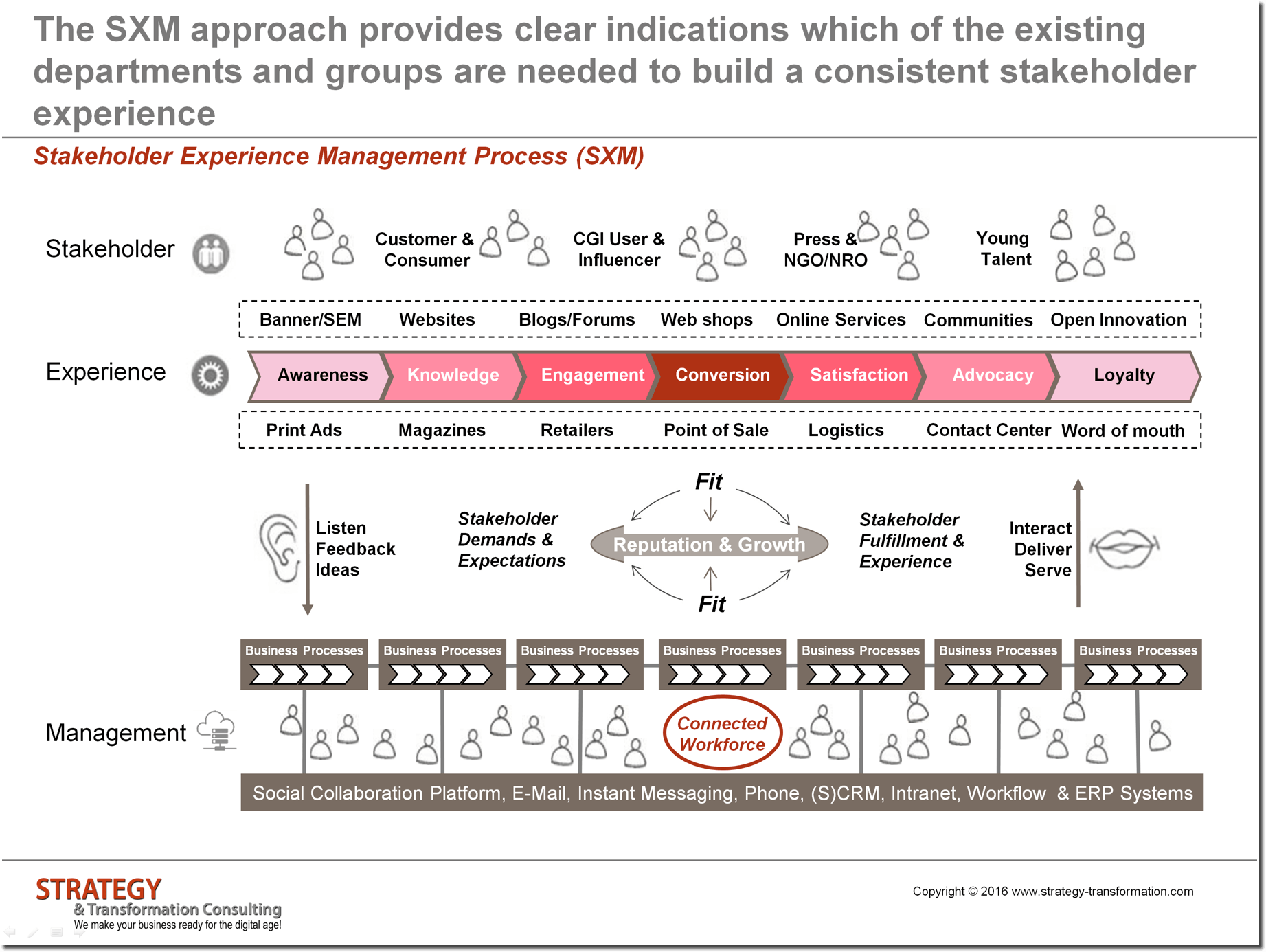Connected Company – Key Enabler for Digital

When we talk about the Digital Transformation, we often think of new business models, involving the customer in our value creation network, social listening & marketing, touch points, connected devices, customer experience, social media, …
…open innovation, online and offline channels and all of this is absolutely correct and essential. It is important to approach the digital transformation from the outside of a company, to view it from the customer’s end, to come from the markets, existing and potentially new ones. Because this is what it’s all about and where the huge external opportunities are waiting: enhanced customer value by innovative digital products and systems, digital communication channels, and a customer experience that is so convincing that he or she is willing to pay for it.
The customer front-end
In recent years much has been accomplished on the customer front-end. Especially marketing, communication and sales have modernized their businesses and tools by actively using social media, customer platforms, direct dialog and exchange with the customer to better understand and serve its likes, opinions, needs. Customer touch points were analyzed along the sales funnel, from the first contacts via a website or banner ad to engagement programs, targeting the important conversion phase and the point of sale. Subsequent advocacy and loyalty programs keep the customer in the loop and ideally make it the brand advocate. All of this is known. You find tons of literature on social marketing and how important it is in a digitalized world. Although some might say – and I tend to agree – that marketing in its classic role no longer exists in a digital world. Why? Because the social customer is so well informed, knowledge is so transparent and available that it’s him or her who decides who to listen to, and more importantly, whom to believe.

Power is shifting…
But this is a different story. Let’s get back to all these touch points the customer might encounter along its journey before the “conversion” takes place and of course, afterwards. And let’s extend the customer term to stakeholder, because as a company you do not have customers only. There are suppliers, partners, talents and all kinds of people a firm has a relationship to. In the end, all of them should benefit from the digital/social experience. In this context digital and social are synonyms, because digital describes a technology that is needed to transform business to a social business. Just like digital is needed to extend a product and service portfolio towards systems that offer an enhanced customer experience and benefit.
Stakeholder experience management (SXM)
If you wish to create for your external stakeholders an exceptional, consistent experience across all channels and touch points while at the same time benefit from the data that is being generated along this journey, you will have to look at the funnel in a holistic manner. Although the (big) data topic is highly interesting and important as well, we should for now take a closer look at another aspect: the challenges for the organization behind SXM: Just picture yourself and the steps you would take when considering a new purchase. Starting from collecting information and reviews to comparing prices and features to potentially negotiating you will eventually decide for or against a specific deal. Let’s assume you have purchased and the “conversion” has taken place, you will then expect best-in-class customer service. If the product or brand is attractive, you might consider additional offers or expect some payback or discount in case you decide for another product of the same company.

Now look at this customer journey from the company’s perspective. Can you imagine how many different departments must closely collaborate to create this consistent online and offline outside appearance? And even more, what it takes to align the systems and data management tools needed for this? Especially big companies with their often very diverse IT landscape and complex organizations that are typically not built around customer journeys will be facing a major challenge to do so. This brings me back to one of the key aspects of the digital evolution: the crucial necessity of a digital strategy and the subsequent alignment of the involved organization. How do you do this? By building a connected company centered on your external stakeholders…
Building a Connected Company
Starting from the digital strategy, the SXM approach will give clear indications which of the existing departments and groups are needed to build this consistent outside picture. They all have their share, might it be marketing, sales, customer service, product management, IT or the business process people. It will make sense to start with the business processes. They determine how work is done and are the basis for IT implementation. Don’t start somewhere else. Re-design your business processes coming from the outside.
How do you want to interact with your stakeholders and who does it? What kind of data and information is needed, where is data stored, who needs access, who are recipients of this data and what should they do with it? How does stakeholder interaction align with your internal information flows and decision patterns? And very fundamental: how customer-centric are your own business operations? In other words: how important is the customer’s voice in your internal decision processes and workflows? Doing this business process analysis properly will very soon reveal the gaps, where systems are not compatible, where the organization needs to better collaborate or where workflows need some update. Although the functional division of labor still dominates the organization of many firms, work usually follows a certain flow or value stream through the organization.
Any work output has typically someone who receives it, may it be inside the same department or outside. This recipient will, just like an ordinary customer, expect a certain quality of work, amount, content, or timing. Any negative deviation from these expectations will lead to iterations, delays and sub-optimal work results. So it might be a good exercise to not only look at the outside boundary and touch points between a company and its stakeholders, but to look at similar relationships and interfaces inside the company. Making satisfied (external and internal) clients the top of your priority list does not necessarily mean you need to change your organizational structure, but you might have to reconsider your existing workflows and, even more importantly, how quality of work is being rated. And in many cases it might mean a fundamental change in mindset and attitude…customers first!

Communities, projects and the line organization
Project-type work dominates more and more our daily business. The digital evolution with its volatility, uncertainty and continuously shortening innovation cycles accelerates this trend even further. Organizational agility becomes a key enabler. But how do you make a grown organization agile? Besides introducing agile working methods and tools an important step is to establish networks and connections across the existing organization. Networks can be built around topics, products or customers. If these networks are built as virtual teams, we often call them communities. If they are “real” organizational elements, we typically refer to them as projects. Setting up traditional project structures always means building a temporary organization that exists in parallel to the line organization. It is an exception to the rule; otherwise you would not need it as a separate unit. Its only purpose is to secure the specific framework the project (and the customer behind) requires.

Anybody who has worked in project structures will be familiar with the difficulties and conflicts projects have with the grown line organization: from the challenge to quickly staff teams with the best people from the line to internal fights over budgets and priorities, to returning resources at the end of the project life cycle. Projects may win these struggles – provided the project sponsor or leader is powerful enough and the project’s objective is important. Top management attention and escalation is always effective and can create the specific environment a particular project might need. However, if this is not granted, projects are generally much more vulnerable against outside effects such as budget cuts or headcount freeze than the powerful line organization. And, their installation and dissolution remains slow… the opposite of agile.
Let’s take the next step now: What if we were not only talking about a few prominent projects with high management attention, but rather a whole business that is best run in a project-type manner such as acquisition projects in sales, development projects in engineering, or innovation projects in R&D? Then we should consider to not make these projects parallel to the line organization but as the core part of it. When customer-centered project structures become the core of the organization, it will have substantial implications for the rest of the company setup. Why? As we know from software development, real agility and speed can only be obtained in small team structures. If teams are small, but at the same time in charge of the business or even P&L responsible, they will need fundamental support by the rest of the organization, especially in those areas which are not the key competencies of the small team. This means that the main mission for most of the line organization becomes to best serve those agile teams just as if they were their clients – as shared services. Shared to secure the synergies across the organization; services as they put the teams’ (=clients) success in the center of their attention and work.
However, developing a service culture is just one of many tasks on the road to becoming an agile, connected company. Making standards more flexible and dynamic, establishing knowledge hubs for strategic capabilities and granting access to these centers of competency, revising leadership principles and appraisal systems, reconsidering core business processes for planning and execution are just a few examples for areas where fundamental change will be necessary. Sounds difficult? It is, because “one-fits-all” does not work here. Unfortunately, there is no blue print. Each company has to find its own way. It can be helpful though to start with an internal discussion on basic leadership and organization principles derived from the company’s (digital) vision, mission and strategy. The step-by-step application of these principles to the day-to-day business will then kick-off a continuous change process which will soon become the more demanding part. Top management will have to drive this change early enough to prepare the company for the future while not endangering its existing business. And ideally all this happens still in good times before sales figures start declining…
Weiterführende Links
Fachkompetenz strukturelle Ausrichtung
About us
Our positioning and mission statement: “Mastering the Digital Age!” We are an integrated management and technology consulting group and offer the conception and implementation of holistic digitization solutions in an integrated manner. In combination, you will receive strategic advice from us on the digitization of your company from real thought leaders with profound methodological knowledge, extensive transformation experience from successful IT system integrators with many years of industry experience and a high level of technological understanding, as well as deep expertise in generating value from data – the new gold of the 21st century – with the help of the latest artificial intelligence (AI) and cloud computing technologies. All this End2End from a single source for the entire transformation process! Find out more about us here.
Ihre Ansprechpartner
Haben wir Ihr Interesse geweckt? Dann schreiben Sie uns oder rufen Sie uns an. Sehr gerne stellen wir Ihnen unsere Beratungsprodukte sowie Fach- und Branchenkompetenzen in einem persönlichen Gespräch detailliert vor. Wir freuen uns darauf, Sie kennenzulernen!

Rüdiger Schönbohm
Partner
Strategy & Transformation Consulting
Email senden

Kommentare geschlossen